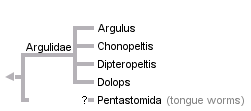Branchiura
Sea lice, fish lice, tongue worms



This tree diagram shows the relationships between several groups of organisms.
The root of the current tree connects the organisms featured in this tree to their containing group and the rest of the Tree of Life. The basal branching point in the tree represents the ancestor of the other groups in the tree. This ancestor diversified over time into several descendent subgroups, which are represented as internal nodes and terminal taxa to the right.

You can click on the root to travel down the Tree of Life all the way to the root of all Life, and you can click on the names of descendent subgroups to travel up the Tree of Life all the way to individual species.
For more information on ToL tree formatting, please see Interpreting the Tree or Classification. To learn more about phylogenetic trees, please visit our Phylogenetic Biology pages.
close boxReferences
Abele, L. G., W. Kim, and B. E. Felgenhauer. 1989. Molecular evidence for inclusion of the phylum Pentastomida in the Crustacea. Molecular Biology and Evolution 6:685-691.
Abele, L. G., T. Spears, W. Kim, and M. Applegate. 1992. Phylogeny of selected maxillopodan and other crustacean taxa based on 18S ribosomal nucleotide sequences: a preliminary analysis. Acta Zoologica 73:373-382.
Almeida, W. D. and M. L. Christoffersen. 1999. A cladistic approach to relationships in Pentastomida. Journal of Parasitology 85:695-704.
Fryer, G. 1968. The parasitic Crustacea of African freshwater fishes: their biology and distribution. Journal of Zoology London 156:45-95.
Fryer, G. 1982. The Parasitic Copepoda and Branchiura of British Freshwater Fishes: A Handbook and Key. Freshwater Biological Association, Scientific Publication No. 46. 87 p.
Lavrov, D. V., W. M. Brown, and J. L. Boore. 2004. Phylogenetic position of the Pentastomida and (pan)crustacean relationships. Proceedings of the Royal Society of London Series B 271(1538):537-544.
Maas, A. and D. Walossek. Cambrian derivatives of the early arthropod stem lineage, pentastomids, tardigrades and lobopodians - An 'Orsten' perspective. Zoologischer Anzeiger 240:451-459.
Overstreet, R. M., I. Dyková, and W. E. Hawkins. 1992. Branchiura. Pages 385-413 in: Microscopic Anatomy of the Invertebrates, Volume 9: Crustacea. F. W. Harrison and A. G. Humes, eds. Wiley-Liss, Inc., New York.
Riley, J. 1986. The biology of pentastomids. Advances in Parasitology 25:45-128.
Riley, J., D. M. Spratt, and P. J. A. Presidente. 1985. Pentastomids (Arthropoda) parasitic in Australian reptiles and mammals. Australian Journal of Zoology 33:39-53.
Storch, V. and B. G. M. Jamieson. 1992. Further spermatological evidence for including the Pentastomida (tongue worms) in the Crustacea. International Journal for Parasitology 22:95-108 .
Walossek, D., J. E. Repetski , and K. J. Müller. 1994. An exceptionally preserved parasitic arthropod, Heymonsicambria taylori n. sp. (Arthropoda incertae sedis, Pentastomida), from Cambrian-Ordovician boundary beds of Newfoundland, Canada. Canadian Journal of Earth Sciences 31:1664-1671.
Walossek, D. and K. J. Müller. 1994. Pentastomid parasites from the Lower Paleozoic of Sweden. Transactions of the Royal Society of Edinburgh-Earth Sciences 85:1-37.
Zrzavy, J. 2001. The interrelationships of metazoan parasites: a review of phylum- and higher-level hypotheses from recent morphological and molecular phylogenetic analyses. Folia Parasitologica 48:81-103.
About This Page
Page copyright © 2002
All Rights Reserved.
Citing this page:
Tree of Life Web Project. 2002. Branchiura. Sea lice, fish lice, tongue worms. Version 01 January 2002 (temporary). http://tolweb.org/Branchiura/6248/2002.01.01 in The Tree of Life Web Project, http://tolweb.org/





 Go to quick links
Go to quick search
Go to navigation for this section of the ToL site
Go to detailed links for the ToL site
Go to quick links
Go to quick search
Go to navigation for this section of the ToL site
Go to detailed links for the ToL site